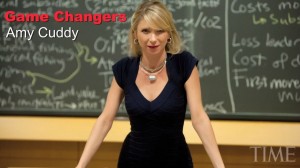Posture, Attitude, and Amy Cuddy

Power Pose.
Suellen and I went to the Tattered Cover bookstore (a Denver icon) last night to hear Amy Cuddy speak about her new book, Presence: Bringing Your Boldest Self To Your Biggest Challenges.
I’ve written about Cuddy before (here, here, and here) and use some of her work in my Critical Thinking class. We all have a general understanding of how the mind affects the body. Cuddy asks us to consider the reverse – how does the body affect the mind? Cuddy points out that the way we carry ourselves – our posture and body language – can affect our mood, thoughts, and performance. She introduces the topic quite well in her famous TED talk – the second most watched TED talk ever.
Cuddy writes that our posture affects our power over ourselves (as opposed to power over other people). When we adopt an expansive posture – making ourselves big – our power to manage ourselves and perform optimally increases. When we adopt a drawn-in posture – making ourselves small – we give away power over our own performance.
Cuddy has covered this ground before (here and here, for instance). So, what’s new? Here’s what I learned in last night’s talk:
- It’s not about outcomes; it’s about process – Cuddy gets thousands of e-mails from people who explain that they didn’t do well in a challenging process, like a job interview or an audition. But they’re not asking for advice on how to change the outcome. Instead, they’re asking how to perform the process better. This strikes me as being akin to decision theory — judging decision quality focuses on the process, not the outcome.
- It’s about your authentic self – when we are present, our body language and our spoken language reinforce each other. When we’re not present, our body language tells a different story than our spoken language.
- Two minutes is overemphasized – in her TED talk, Cuddy explains that holding an expansive posture – a power pose – for two minutes will change our hormones in positive ways. She explained last night that two minutes is not a magic number; even a few seconds is helpful.
- Animals helped us develop this idea … — Cuddy noted the influence of the naturalist Frans de Waal who explained, in his classic book, Chimpanzee Politics, how chimps adopt expansive postures to get what they want.
- … and we can, in turn, help animals – a horse trainer (@seriouspony) who was familiar with Cuddy’s work tried posture therapy on one of her Icelandic ponies who was suffering from “profound depression”. Here’s a video that shows the results.
- It has an impact on PTSD – Cuddy mentioned her friend and fellow researcher, Emma Seppälä, who has used posture therapy on combat veterans with PTSD. The results are encouraging.
- Gender – little boys and girls are equally likely to adopt expansive poses. But by the age of six (roughly) girls are starting to adopt more drawn-in poses while boys continue to be expansive. Cuddy suggests that, if we want to promote gender equality, we might start by changing this learned behavior.
- Imagination – it’s not always convenient to strike a power pose. Cuddy believes that simply imagining yourself in a power pose can be beneficial.
- Even the master needs reminders – Cuddy explained how an Internet troll had put her in a funk. Her husband reminded her to check and change her body language. She now carries a copy of her own book with a hand written note: “Remember to take your own advice”. Bottom line – we need to think about our body language; it doesn’t just change by itself.
- Where to next? – Cuddy’s many correspondents have noted that people on the autism spectrum and people with dementia both tend to adopt drawn-in postures. They make themselves small. Cuddy wonders if helping them learn to make themselves big would help.
Cuddy is a fascinating speaker – her body language definitely reinforces here spoken language. I recommend the book. Just remember that were you stand depends on how you stand.
Cuddy presented at the Tattered Cover with openness and refreshing candor. Her enthusiasm was infectious.